Recent applications and chiral separation development based on stationary phases in open tubular capillary electrochromatography(2019-2022)
Xinyu Li , Qinjie M , Xingti Zheng , Qin Chen , Xiodong Sun,b,*
a Shanghai Engineering Research Center of Organ Repair, School of Medicine, Shanghai University, Shanghai, 200444, China
b Shanghai Key Laboratory of Bio-Energy Crops, School of Life Sciences, Shanghai University, Shanghai, 200444, China
c Institute of Translational Medicine, Shanghai University, Shanghai, 200444, China
Keywords:
Capillary electrochromatography
Open tubular capillary
Chiral separation
Stationary phase
Capillary electrophoresis with mass
spectrometry (CE/MS)
ABSTRACT Capillary electrochromatography (CEC) plays a significant role in chiral separation via the double separation principle,partition coefficient difference between the two phases,and electroosmotic flow-driven separation.Given the distinct properties of the inner wall stationary phase(SP),the separation ability of each SP differs from one another.Particularly, it provides large room for promising applications of open tubular capillary electrochromatography (OT-CEC).We divided the OT-CEC SPs developed over the past four years into six types:ionic liquids,nanoparticle materials,microporous materials,biomaterials,nonnanopolymers, and others,to mainly introduce their characteristics in chiral drug separation.There also added a few classic SPs that occurred within ten years as supplements to enrich the features of each SP.Additionally,we discuss their applications in metabolomics,food,cosmetics,environment,and biology as analytes in addition to chiral drugs.OT-CEC plays an increasingly significant role in chiral separation and may promote the development of capillary electrophoresis (CE) combined with other instruments in recent years,such as CE with mass spectrometry(CE/MS)and CE with ultraviolet light detector(CE/UV).
1.Introduction
Chirality is an important property of nature and an inherent property of biomolecules,such as amino acids(AAs),proteins,and carbohydrates.Different chiral structures between enantiomers have completely different pharmacological, toxicological, and biological activities, such as left and right hands in humans, with a discrepancy in function.This phenomenon clarifies that the chiral structure of drugs is an important part of drug quality testing.In other words, enantioseparation has continued to be a hot topic in pharmaceutical science, agrochemical, environmental, and food analysis.
Among the diverse separation techniques, capillary electrochromatography (CEC) exhibits unique strengths, integrating the useful features of capillary electrophoresis (CE) and highperformance liquid chromatography (HPLC), thus becoming an attractive tool for enantioseparation.As a hybrid technique, CEC is driven by the retention differences between stationary phases(SPs)and mobile phases,and electroosmotic flow(EOF).Capillary columns in CEC have three types:open tubular(OT)columns,monolithic columns,and packed columns(Fig.1).The OT column has a higher column efficiency than the monolithic column and a simpler preparation process than the packed column.OT columns also have the advantages of tolerating high pressure and being difficult to collapse[1].

Fig.1 .Three categories of capillary columns.(A) Open tubular (OT) column, (B)monolith column, and (C) packed column.
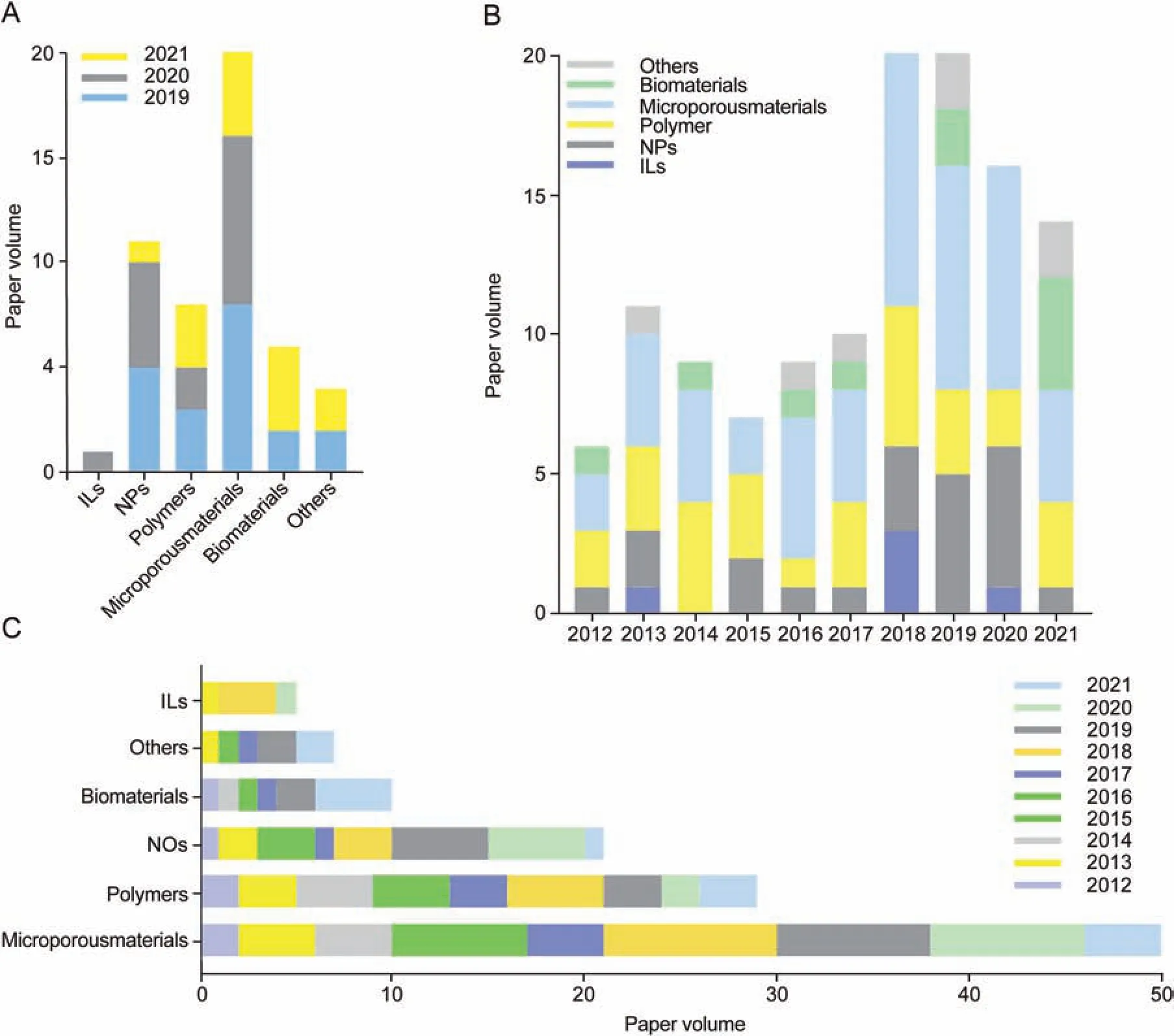
Fig.2 .The number of chiral open tubular capillary electrochromatography(OT-CEC)papers published in recent years.(A)Paper volumes of chiral stationary phases(SPs)in OT-CEC from 2019 to 2021,(B)paper volumes of chiral SPs in OT-CEC from 2012 to 2021,and(C)annual paper volumes of six types of chiral SPs in OT-CEC in 2012-2021.IL:ionic liquid;NP:nanoparticle.
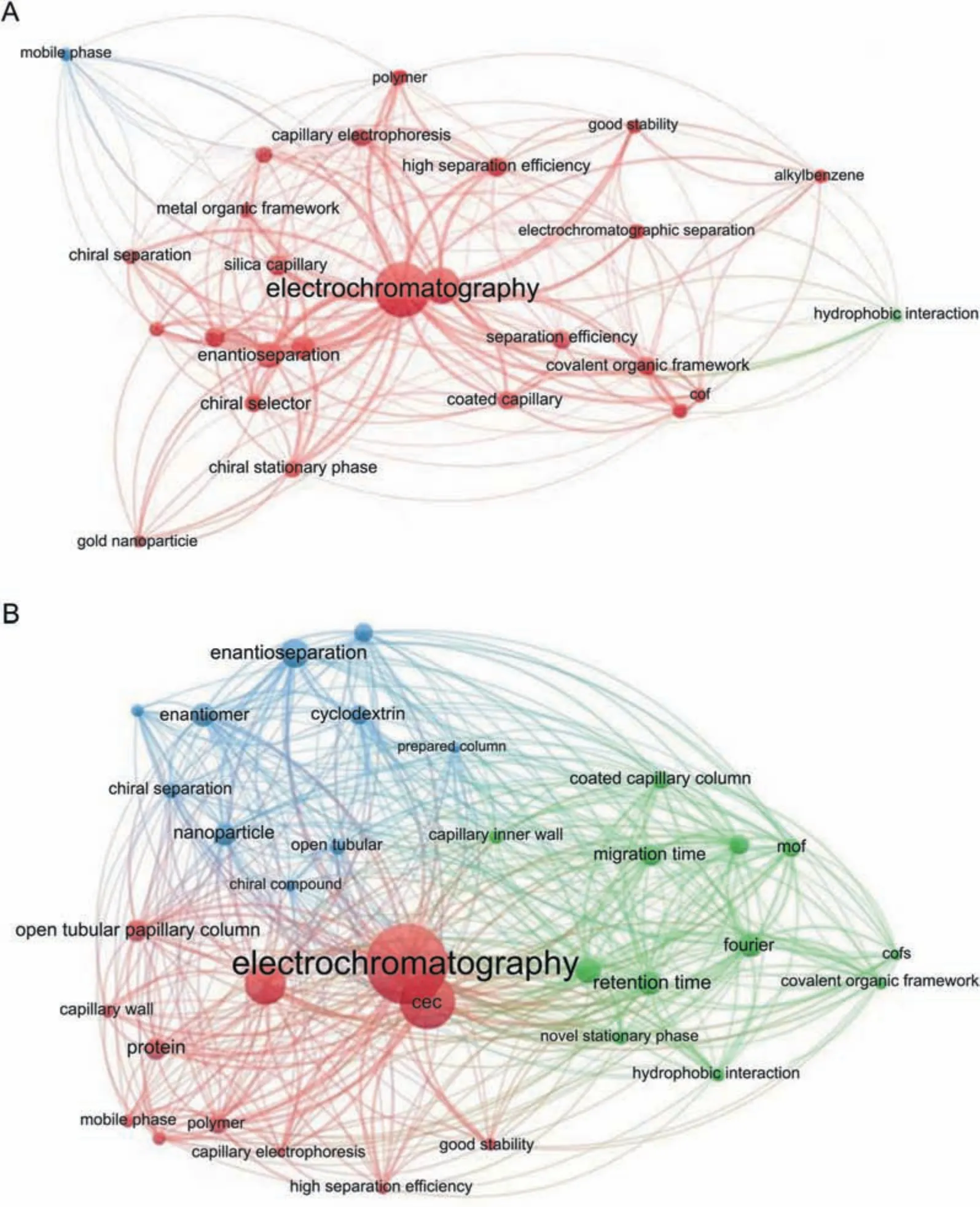
Fig.3 .Correlations of open tubular capillary electrochromatography(OT-CEC)keywords in recent years.(A)2019-2021,and(B)2012-2021.The circle size represents the frequency of occurrence of the word, and the distance between two linking circles represents the correlation between them.The data for the entire year of 2022 was not available while writing this review, so it is not being considered in the graphs.
These advantages allow the OT column to merge gradually in separation fields.However, the OT column suffers from a phase ratio and a relatively low column capacity, which restricts open tubular capillary electrochromatography (OT-CEC) utilization.The introduction of multifarious materials as SPs has become a promising way to improve sample loading capacity in recent years[2-6].The wide selection space for SPs in CEC offers OT-CEC considerable application prospects,especially for mirror-image chiral molecular enantiomers resolution (Rs) improvement.Therefore, this review discusses coating materials and development in chiral analyte separation via OT-CEC over the past four years, adding classic coatings within 10 years for the supplement.It concludes with the applications of OT-CEC, capillary electrophoresis with mass spectrometry (CE/MS), and other techniques in medicine and clinical,metabolomics, food and cosmetics, biology, and environmental fields.
Overall,we provide readers interested in OT-CEC with the most up-to-date overview of this field, and the related new SPs from 2019 to 2022 are listed in Table 1 [3,5-65].PubMed and Web of Science were used to search the following characters (also their acronyms) alone or in combination: “Open tubular”, “Capillary electrochromatography”, “Chiral separation”, “Stationary phase”,and “Coating” for relevant literature to analyze recent OT-CEC developments.It should be noted that we did not incorporate all relevant papers within the stated period,and no bias was present in the selection of the literature.
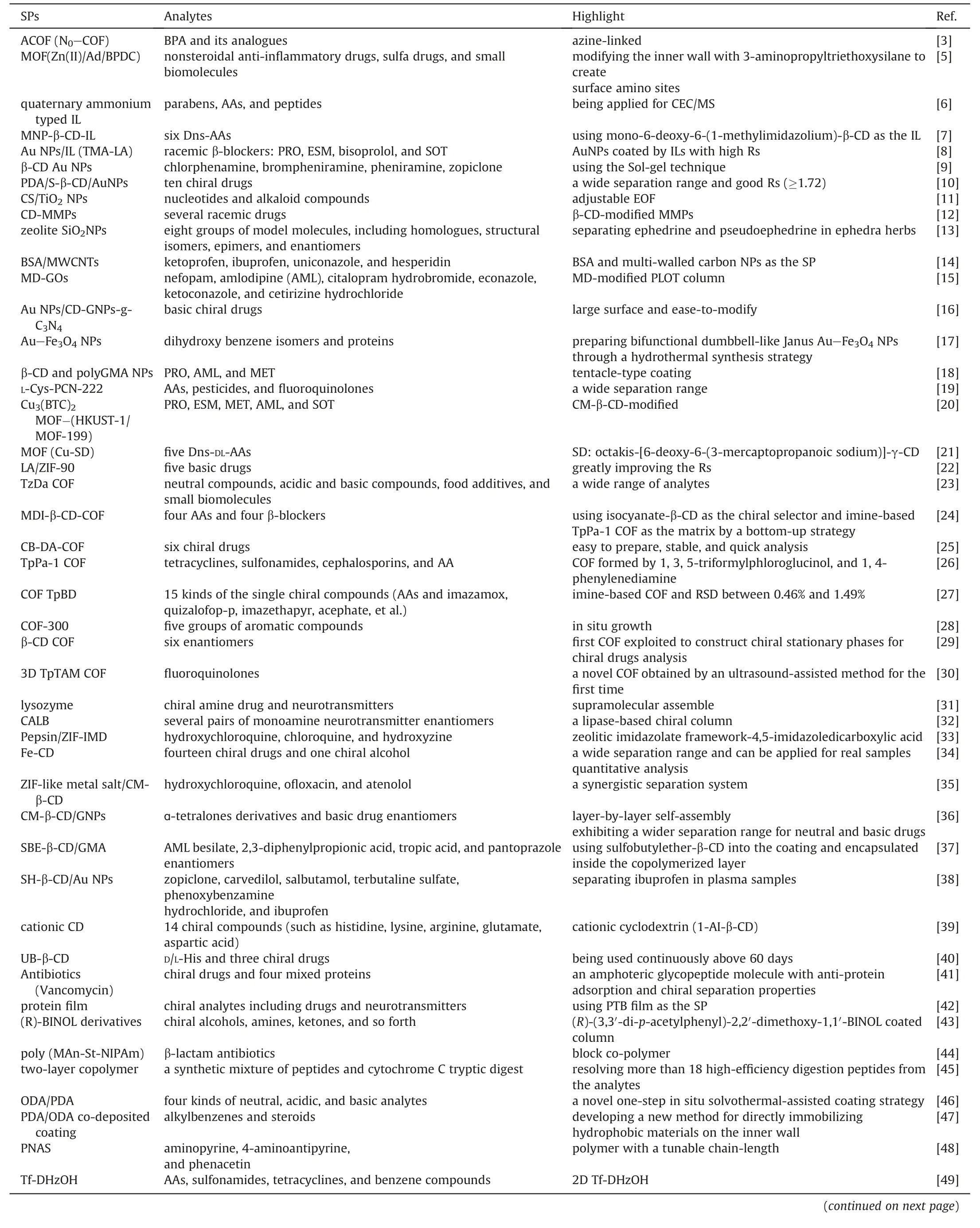
Table 1 New stationary phases (SPs) of OT column from 2019 to 2022.

Table 1 (continued)
2.Overview of the OT-CEC
New SPs in CEC can increase the specific surface area of OT columns; however, the column capacity is still a major research focus.A few SPs and their modified coating methods have also been developed in the past few years,and the proportion and correlation of OTcolumns in CEC in recent years have been shown in Figs.2 and 3.A considerable number of covalent-organic frameworks (COF)and metal-organic frameworks (MOF) OT columns have been prepared in recent years.In contrast,ionic liquids(ILs)OT columns are rare.We divided the SPs developed within the past four years into six types.The remaining OT columns in the different types are at a medium level.The SP of the biomaterial-based OT columns is divided into two main types: enzymes, and carbohydrates.Porous materials and nanoparticle (NP) materials and their application in CEC allow the increasing use of OT-CEC.They have various separations, including chiral drugs, environmental water, and clinical samples.A few interesting SPs have been developed and are introduced in the following section.It shows that the development of OT columns still maintains a generally upward trend within ten years, despite a decline in the past two years.Regarding the instrument combination of OT-CEC, there is an expected improvement in CE/MS,which may help the development of metabolomics and clinical fields.
3.Advances in chiral separation of OT-CEC based on SP materials
3.1.Ionic liquid-based SP in OT-CEC
ILs are liquid salts (at room temperature) comprising anions and cations[66],including molten salts and organic ionic liquids.The uniformity of the coating dispersion in the capillary column directly affects the separation effect of the analytes.ILs are less affected by column dispersion than solid materials and have better compatibility with CE [67].Yang et al.[7] prepared the magnetic nanoparticles-β-cyclodextrin-ionic liquid (MNP-β-CDIL) OT column for the separation of six chiral AAs enantiomers,andmono-6-deoxy-6-(1-methylimidazolium)-β-cyclodextrin tosylate was selected as the IL in it (Fig.4).Chiral selectors aid in the separation of resolved enantiomers by binding to specific sites.By using tetramethylammonium lactobionate (TMA-LA) ILs as the buffer to create a chiral environment, Sun et al.[8] prepared a novel bilayer chiral SP (Au NP and carboxymethyl-βcyclodextrin (CM-β-CD)) to enhance the OT column separation ability.The Rs of the β-blockers enantiomers such as propranolol(PRO), esmolol (ESM), bisoprolol, and sotalol (SOT) were 6.29,6.11, 6.12, and 6.02, respectively.In 2013, Stavrou et al.[68]dissolved polysaccharides into ionic liquids to manufacture an OT column, which has good separation validity for sodium thiopental and can also separate SOT and three cellulose derivatives.These results suggest that the combination of ILs with other materials may yield unexpected results.ILs deserve more attention in OT-CEC; however, there have been few ILs used as SPs alone in the last three years, because of their size limited.Deep eutectic solvents (DESs) are novel green and environmentally friendly ILs with the advantages of simple preparation, low cost, low toxicity, and good biodegradability.Currently, DESs have been applied in capillary isoelectric focusing electrophoresis [69] and electrokinetic chromatographic separation [70].However, there are no reports on DES use in OT-CEC.
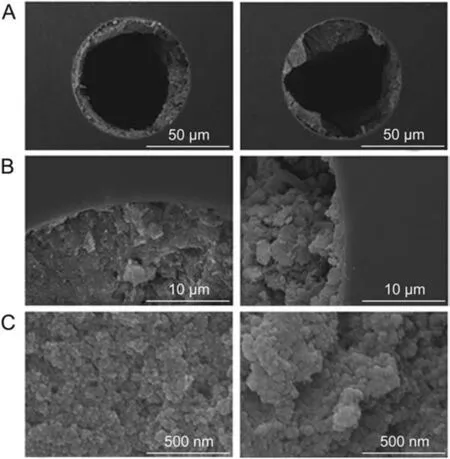
Fig.4 .Scanning electron microscopy (SEM) depicts the cross-section of ionic liquids open tubular (OT) columns at different magnifications.(A) 50 μm, (B) 10 μm, and (C)500 nm.Left:magnetic nanoparticles-β-cyclodextrin coated capillary;Right:magnetic nanoparticles-β-cyclodextrin-ionic liquid coated capillary.Reprinted from Ref.[7]with permission.
3.2.Nanomaterial-based SP in OT-CEC
Given their large specific surface area and excellent surface chemistry properties,nanomaterials are considered to be preferred for the permanent or dynamic surface coating of OT-CEC.NPs are a better choice for pseudo-SPs in background electrolytes.Using NPs as capillary wall coatings can effectively improve the Rs[71].NPs in biological samples will form the outer layer on their surface, and this structure is called the“protein corona”.It is formed not only by proteins but also by other biomolecules in vivo [72].NPs with different physicochemical properties can adsorb substances with various characteristics,which may provide another explanation for the enrichment and separation functions of modified NPs.
3.2.1.Metal (magnetic)/inorganic (oxide)
NPs usually act as carriers or adsorbents for chiral selectors during chiral separations.The metals commonly used for chiral separation include gold (Au) [10], iron(Fe)[12], titanium (Ti) [73],and zinc (Zn) [74] (Fig.5).β-CD [75] and bovine serum albumin(BSA) [76] are often used to modify them.For instance, Au NPs as the SP can improve the performance[9]of OT-CEC columns and are widely used [77,78] in CEC.A capillary column (Fig.5A) of βcyclodextrin-Au(β-CD-Au)NPs prepared by a layered self-assembly method could separate metazol and its three intermediate enantiomers[10].Further synthesis of the sol-gel-coated β-cyclodextrin(SH-β-CD) coupled polydopamine-Au (PDA-Au) NPs OT column could separate seven analytes, including chiral AAs and drug enantiomers.Finally, sulfated-β-CD (S-β-CD) was decorated onto the Au NPs-coated capillary pretreated with polydopamine (PDA).It achieved baseline separation of the 10 chiral drugs.
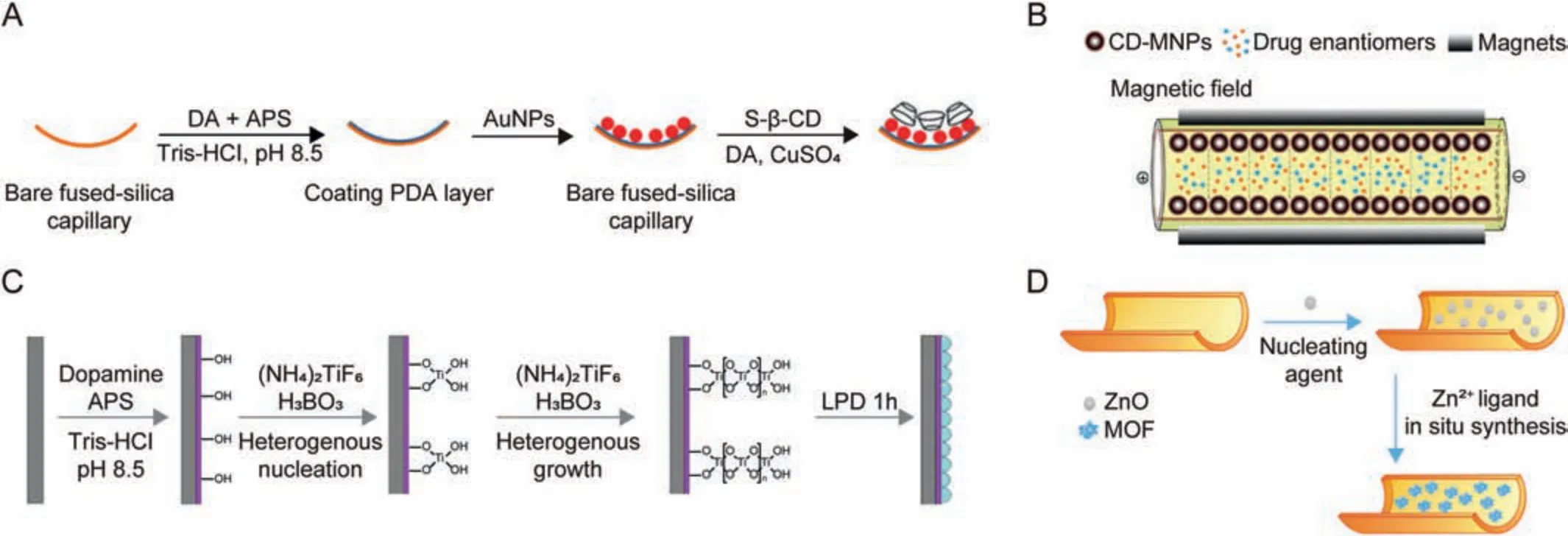
Fig.5 .Four types of metal nanoparticles modified in open tubular capillary electrochromatography (OT-CEC) capillaries.(A) Au, (B) Fe, (C) Ti, and (D) Zn.DA: dopamine; APS:ammonium persulphate; Tris: tris(hydroxymethyl) aminomethane; HCl: hydrochloric acid; PDA: polydopamine; AuNPs: gold nanoparticles; S-β-CD: sulfated-β-cyclodextrin; CDMMPs:carboxymethyl-β-cyclodextrin-modified 3-aminopropyltriethoxysilane-Fe3O4 magnetic microparticles;LPD:liquid phase deposition;and MOF:metal-organic frameworks.Reprinted from Ref.[10,12,73,74] with permission.
Magnetic nanoparticles (MNPs), such as Fe NPs, can be rapidly prepared in columns using magnet pairs.Sun et al.[12]prepared an OT column with CM-β-CD functionalized Fe3O4magnetic particles(CD-MMPs)as the SP(Fig.5B)in 10 min for chiral drug enantiomers separation.It is convenient to remove and recover the column.Furthermore, carboxyl-modified MNPs deposited by electrostatic self-assembly on positively charged poly-diallyldimethylammonium chloride on the capillary inner surface [79] improved theperformances of protein variants and protein glycoisoforms separation.Directly using Ti oxides or forming hybrid polymers with Ti can be a type of SP,and a thin-layer TiO2OT column coupled with mass spectrum (MS) can also be used for the enrichment of trace phosphopeptides in biological samples [80].As a pretreatment material,PDA helps modify or adsorb other substances onto the capillary inner wall more conveniently.The chelation of TiO2NPs in capillary columns after PDA pretreatment (Fig.5C) effectively separated four proteins(conalbumin,α-lactalbumin,β-lactoglobulin,and BSA),and eight ovalbumin(OVA)sugar subunit standards.It can separate two β-lactoglobulin variants in egg white samples and five glycated isomers of OVA[73].(NH4)2TiF6combined with chitosan(CS)as the SP can separate three alkaloids and four nucleotides in 11 min [11].Changing the material deposition time or CS concentration can tune the magnitude and direction of EOF,and enhance the applicability of the columns.
Inorganic nanomaterials used for chiral separation include silica(SiO2) and polystyrene [76].Based on the covalent bonding of silanol groups and the strong PDA adhesion, Zhao et al.[13] used zeolite SiO2NPs as SP materials for the first time to prepare two chiral columns, coated with SiO2NPs and BSA@zeolite SiO2NPs/PDA, respectively.It is simple to prepare and does not require a water bath or nitrogen purge.PDA attaches BSA to the silanol groups.BSA not only exposes amino groups to reduce the EOF value but also provides more chiral sites.Under the same electrophoresis conditions,the coating with a smaller inner diameter(50 nm)was more compact, and the shorter column had an equivalent or a larger number of plates(effective length:30 cm >40-50 cm).Both two aspects showed a better separation performance.However,multilayer NPs are difficult to be modified on the inner wall.To solve this problem,Qu et al.[81]adsorbed negatively charged SiO2NPs and positively charged amino groups on the inner wall through strong electrostatic interactions, and then derivatized them with octadecyltrichlorosilane.The coating thickness was adjusted in the range of 130-600 nm.A three-layer modified column can separate both acidic and basic proteins and four OVA glycoisoforms.
Quantum dots(QDs)are semiconductor nanostructures,such as silicon and cadmium sulfide QDs.To date,no QD coating OT column has been reported for chiral drug separation.A few studies have shown that adding CdTe QDs in CE buffer is beneficial for not only reducing the detection limitation levels in dopamine (DA) and norepinephrine (NE) but also increasing the determination sensitivity [82].This suggests the large exploration possibility of using QDs for enantiomeric separation.
3.2.2.Carbon nanotubes (CNTs)
Single/multi-walled carbon nanotubes (S/MWCNTs) and graphene oxide (GO) are carbon-based nanomaterials.The R- and Sconfigurations of drugs exhibit different pharmacological effects.Carboxylated SWNHs [83] can be used to effectively separate nonsteroidal anti-inflammatory drugs (NSAIDs).MWCNTs improve the separation efficiency of complex samples,because of their large specific surface area.The column prepared by Bai et al.[14] using BSA-coupled MWCNTs (Fig.6) could separate ketoprofen(Rs = 24.20) and ibuprofen (Rs = 12.81) excellently with stability.Meanwhile, MWCNTs can also effectively separate achiral drugs[84,85].

Fig.6 .Physical characterizations of multi-walled carbon nanotubes(MWCNTs)in each step.Scanning electron microscopy (SEM) depicts the (A) raw sample, (B) the acidtreated MWCNTs, and (C) the cross-section of bovine serum albumin (BSA)/MWCNTs capillary.Reprinted from Ref.[14] with permission.
GOs have the same advantages as CNTs and are easy to be modified.Ma et al.[15] modified maltodextrin (MD) onto the GO coating and successfully separated six chiral enantiomers.Liu et al.[86] used GOs and reductive graphene oxide (GOOH) as raw materials to prepare capillary columns, which separated acidic, basic,and neutral drug enantiomers.GOs prepared into molecularly imprinted polymers(MIPs)as SP can achieve DA,epinephrine(EP),and NE separation.It was successfully applied to determine the aforementioned three substances in human serum and DA hydrochloride injection [87].
3.2.3.Polymer nanocomposites (PLSNs)
PLSNs do not require cross-linking agents.To obtain polymer composites,the dispersion of NPs in a continuous phase polymer is sufficient.However,there is at least one one-dimensional(1D)size of the dispersed phase,reaching the nanometer scale(1-100 nm).The properties of PLSNs are superior to those of conventional polymer composites with the same composition.Jiang et al.[9]improved separation efficiency by SH-β-CD-Au NPs in the column.Through the three-dimensional (3D) network SP, strong chemical bonds were formed between the SP and the inner column surface.Another example is nanosheets composed of Au NPs and g-C3N4,whose surface can be modified with CD[16](Fig.7).The separation ability of this composite column for the five chiral drugs was higher than that of a single material CD-modified NP column.For the same type of materials, the bimetallic Au-Fe3O4NPs SP prepared by hydrothermal synthesis [17] can separate dihydroxybenzene isomers and proteins.

Fig.7 .Transmission electron microscopy(TEM)depicts nanoparticle materials.(A)Au NPs,(B)graphitic carbon nitride,and(C)Au NPs-graphitic carbon nitride.Au NPs:gold nanoparticles.Reprinted from Ref.[16] with permission.
Other applications of non-decentralized composite materials include GO-MNP columns modified with BSA [88] or CD [89] in chip-based OT-CEC, which can separate chiral AAs in approximately 1 min.Sun et al.[18] used glycidyl methacrylate (GMA) to coat capillaries to form whisker-type coatings.They then immobilized PGMA NPs on them to further modify with ethylenediamine-β-cyclodextrin chiral selectors.These columns are used in various applications.It can separate chiral drugs, AAs, and biogenic amines.
3.3.Microporous material-based SP in OT-CEC
3.3.1.MOFs
The sufficient specific surface area of the porous materials compensates for the small sample loading capacity of the capillary columns.MOF materials (Fig.8) comprise metal ions and organic ligands together forming 3D pore structures, which have characteristics of large specific surface areas, complex structures, high porosities, and adjustable cavities [90].The application range of MOF OT columns is considerable [5,19], comprising neutral, acidic,and basic compounds.The HKUST-1@capillary column prepared by Sun et al.[20] used CM-β-CD and MOF-199 as novel SP that can successfully separate five basic chiral drugs,including the benzene series, some dipeptides, AAs, and AA derivatives.Another homochiral MOF,Cu-SD[21],can also recognize chiral AAs.Zeolite imidazole MOF-90 (ZIF-90) with lactic acid (LA) [22] as a chiral selector improved the enantiomeric separation of five chiral drugs:PRO, MET, ATE, BIS, and SOT.Besides common organic synthesis compounds, such as carboxylic MOFs, nitrogen-containing MOFs,and two-dimensional(2D)MOFs,using MOFs as precursors,layered double hydroxides(LDHs)[91]are a new type of OTcolumn coating.However,there are some difficulties in inner wall modification with LDHs.Therefore,they are not widely used.

Fig.8 .Preparations of six types of metal-organic frameworks open tubular capillaries.(A)Zn(II)/Ad/BPDC,(B) L-Cys-PCN-222,(C)Cu3(BTC)2MOF,(D)MOF(Cu-SD),(E)LA/ZIF-90,(F)ZIF-like metal salt/CM-β-CD, (G) PDA/MOFs/BSA, and (H) L-Cys-PCN-224.APTES: 3-aminopropyltriethoxysilane; Bio-MOF-1: (Zn8 (ad)4(BPDC)6O·2Me2NH2,8DMF,11H2O; ad: adeninate; BPDC: biphenyldicarboxylate; PCN-222: Zr-4-carboxyphenylporphyrin-222; L-Cys: L-cysteine; SALI: solvent-assisted ligand incorporation; BTC: 1,3,5-benzenetricarboxlic acid; γ-CD-MOF: γ-cyclodextrin metal-organic frameworks; SD: octakis-[6-deoxy-6-(3-mercaptopropanoic sodium)]-γ-cyclodextrin; AIBN: azodiisobutyronitrile; APIM: N-(3-aminopropyl)-imidazole; 4,5-IMD: imidazole-4, 5-dicarboxylic acid; DA: dopamine; DUT-5: dresden university of technology-5; BSA: bovine serum albumin; γ-MPS: γ-methacryloxypropyltrimethoxy-silane; and TCPP: tetra (4-carboxyphenyl) porphine.Reprinted from Refs.[5,19-22,35,61,62] with permission.
Biocompatible self-assembly artificial metal-peptides(MPA)can create a chiral environment [92].MPA as an SP can achieve moderate to high separation of chiral molecules[93].Polypeptide MOFs are more conducive to the separation of small biomolecules.The concept and development of MPA may be applied to the separation and analysis of clinical biological samples.New changes in MOFs for chiral separation are worth investigating.
3.3.2.COFs
COFs are a class of 3D-ordered organic porous crystalline materials that are connected by covalent bonds with light elements(such as C,O,and N)after MOFs.In the last three years,the number of prepared COF OT columns has been higher than that of other porous materials.The COF capillary columns in the OT-CEC also had a wide determination range.A novel COF(Fig.9)composed of 4,4′,4''-(1,3,5-triazine-2,4,6-triphenylamine (Tz)and 1,4-dihydroxyp-benzaldehyde(Da)[23]can separate the following analytes well:neutral, basic, and acid compounds, as well as small biomolecules(such as AAs and peptides) and food additives (vanillin and its analogs).In recent years, the majority of COF materials contain N.For example,novel nitrogen-linked COF(N0-COF)can separate and detect the environmental endocrine disruptors(EEDs)bisphenol A(BPA)(estrogen-like effect)and its analogs[3].Imino-based TtPa-1 COF [24] and CB-DA-COF [25] OT columns are used for the enantiomeric separation of β-blockers and others.Wang et al.[26]used isocyanate-β-CD as a chiral selector, to decorate a Ttpa-1 COF OT column synthesized from 1,3,5-triformylphloroglucinol(Tp)and 1,4-phenylenediamine (Pa-1), which was used to separate tetracyclines, sulfonamides, cephalosporins, and AAs.The COF TpBDcoated OT column [27] could perform baseline separation of fifteen monochiral compounds and three mixed AAs.It also appeared as a boron-related multilayer COF-5 material.Coating it on preprocessed PDA membrane achieves baseline separation of neutral, acidic, and basic analytes [94].

Fig.9 .The physical characterization and preparation procedures of TzDa@capillary.(A)Scanning electron microscopy (SEM) depicts the TzDa@capillary, and (B) schematic procedures for the fabrication of the TzDa@capillary.APTES: 3-aminopropyltriethoxysilane; Tz: 4,4′,4''-(1,3,5-triazine-2,4,6-triyl)trianiline; Da: 1,4-dihydroxyterephthalaldehyde; and RT: room temperature.Reprinted from Ref.[23]with permission.
COFs are difficult to synthesize in columns.Successful preparation cases have emerged, involving COF-300 prepared by an in situ growth method [28], β-CD COF condensed by the photopolymerization method[29],and 3D TpTAM COF material obtained by ultrasonic-assisted combined cleavage reaction[30].These three COFs have been successfully applied for the separation of chiral substances.Immobilization of biomolecules(such as enzymes,peptides,or AAs)with an inherently strong chiral environment or specific interactions to COFs exhibits high-efficiency chiral separation[95],which may be useful for biomolecular COFs on OT columns.
3.3.3.Porous molecular cages
Porous molecular cages are classified as supramolecular cages(containing metal elements)and porous organic cages(POCs).The former is composed of metal-organic cages(MOCs)coordinated by metal ligands or via hydrogen bonding, whereas the latter is formed by covalent bonding with pure organic building units such as light non-metallic elements (H, B, C, N, and O).Adjusting the ratio of the metal center to the ligand may alter the separation performances.Zhang et al.[96] reported the first OT-CEC racemic separation using homochiral POC CC3-R (Fig.10).This column can separate three chiral drugs and four positional isomers with good stability and repeatability.Porous molecular cages appear more frequently in HPLC and gas chromatography (GC); however, their applications in CE SPs should be further explored.

Fig.10 .The schematic diagram of the POC CC3-R OT column.POC: porous organic cage; CC3-R: a homochiral POC; OT-CEC: open tubular capillary electrochromatography; and SEM: scanning electron microscopy.Reprinted from Ref.[96]with permission.
3.3.4.Ultra-crosslinked polymers
Hypercross-linked polymers(HCPs)are a family of permanently microporous polymer materials characterized by diverse synthetic methods, easy functionalization, high surface area, low-cost reagents,and safe operating conditions[97].The rational selection of monomers, appropriate lengths of cross-linkers, and optimized reaction conditions may prepare polymer backbones with tunable porous topologies.The introduction of other chemical functional groups at a later stage further enhanced its performance.Liu et al.[98] prepared a porous layer open tubular (PLOT) column coated with a polybutylmethacrylate-coethylene glycol dimethacrylate porous layer SP in the presence of different porogens.The number of mesopores and micropores in the coating was higher when a single porogen(one-component porogen solvent)was used.This is four times as much as that generated by three-component porogens.Columns prepared using single porogens have more active sites, which can improve protein separation.Compared with the capillary column dynamically coated with polyvinylpyrrolidone(PVP), it has the same separation efficiency in separating BSA and cytochrome C but has better successive repeatability.
3.4.Biomaterial-based SP in OT-CEC
3.4.1.Enzymes
The essence of enzymes is usually proteins or RNA.Some enzymes in nature can be rationally used to create a chiral environment for enantiomers separation.Sun et al.[31] used phase transition to complete the assembly of lysozyme (a protein enzyme)in a supramolecular membrane-coated OT column in only 1 h.It successfully separates three groups of enantiomers comprising chiral amine drugs and neurotransmitters.The column remained stable after 100 consecutive runs.For other functional enzymes, the candida antarctica lipase B (CALB) [32] column can separate NE, EP, and phenylephrine by simply covalently placing itself in the column.Another example is the use of pepsin modified with zeolitic imidazolate framework-4, 5-imidazoledicarboxylic acid (ZIF-IMD) [33] as the SP, which achieves the baseline separation of hydroxychloroquine, chloroquine, and hydroxyzine.
3.4.2.Carbohydrate
The carbohydrates in separation include disaccharides (such as maltose) and polysaccharides (such as CS, cyclic CD, and its derivatives).Maltose exhibits both alpha and beta conformations.Potolitsyna et al.[99] synthesized three PLOT columns using a maltose derivative of hyperbranched polyethyleneimine (PEI-Mal)at different ratios.The B column(40%)exhibits the best separation efficiency due to the optimal ratio of amino and hydroxyl functional groups,and the A column(90%)coating was more uniform.It can be used to separate albumin, lysozyme, myoglobin, and insulin.
CD [34,35,100] is the most commonly used polysaccharide material for chiral separations and has appeared frequently.It is either a component of a mixed SP or a chiral selective agent used for synergistic separations.Both the bulk inner cavities and outer chiral sites of CD play an important role in the binding of substances to be separated.Both can improve Rs, enhance separation efficiency, or expand separation ranges.Compared to native β-CD, β-CD derivatives have advantages in racemate separation [10].In recent years, CD-related SPs in OT columns have been maintained at a certain amount.Most of the columns re-modified β-CD with other substances as a new SP [36,37] by polymerization.Fang et al.[38]fabricated a column by using negatively charged SH-β-CD/Au NPs to self-adsorb onto a column in which its inner wall was pretreated with poly-diallyldimethylammonium chloride.This helped to separate ibuprofen enantiomers in rat plasma samples.Modification of capillary columns with 1-allylimidazole-β-cyclodextrin(AIβ-CD) [39] also enables the separation of up to 14 chiral compounds.The urea-amino-beta-CD derivative (UB-beta-CD) OT column developed by Li et al.[40]can separate D/L-His and three chiral drugs.
CS is the product of the natural polysaccharide chitin, which removes a part of the acetyl group and has good biocompatibility and biodegradability.By cross-linking CS and SiO2[101] into an OT column,the abundant amine groups and hydroxyl groups on the inner wall can separate nucleotides, aromatic acids, and inorganic anions in the CEC mode through hydrophilic and electrostatic interactions.
Applications of nano-saccharides include polyacrylamide crosslinked nano-CS(2011) [102] and nanocellulose crystals derivativesilica hybrid sol[103](2017)(Fig.11)as the SP.It can be seen from the above that CD SPs have been developed after modification or mixed use.New carbohydrate materials, their functionalization modifications, and their combination with other materials may become new challenges for their development in chirality.
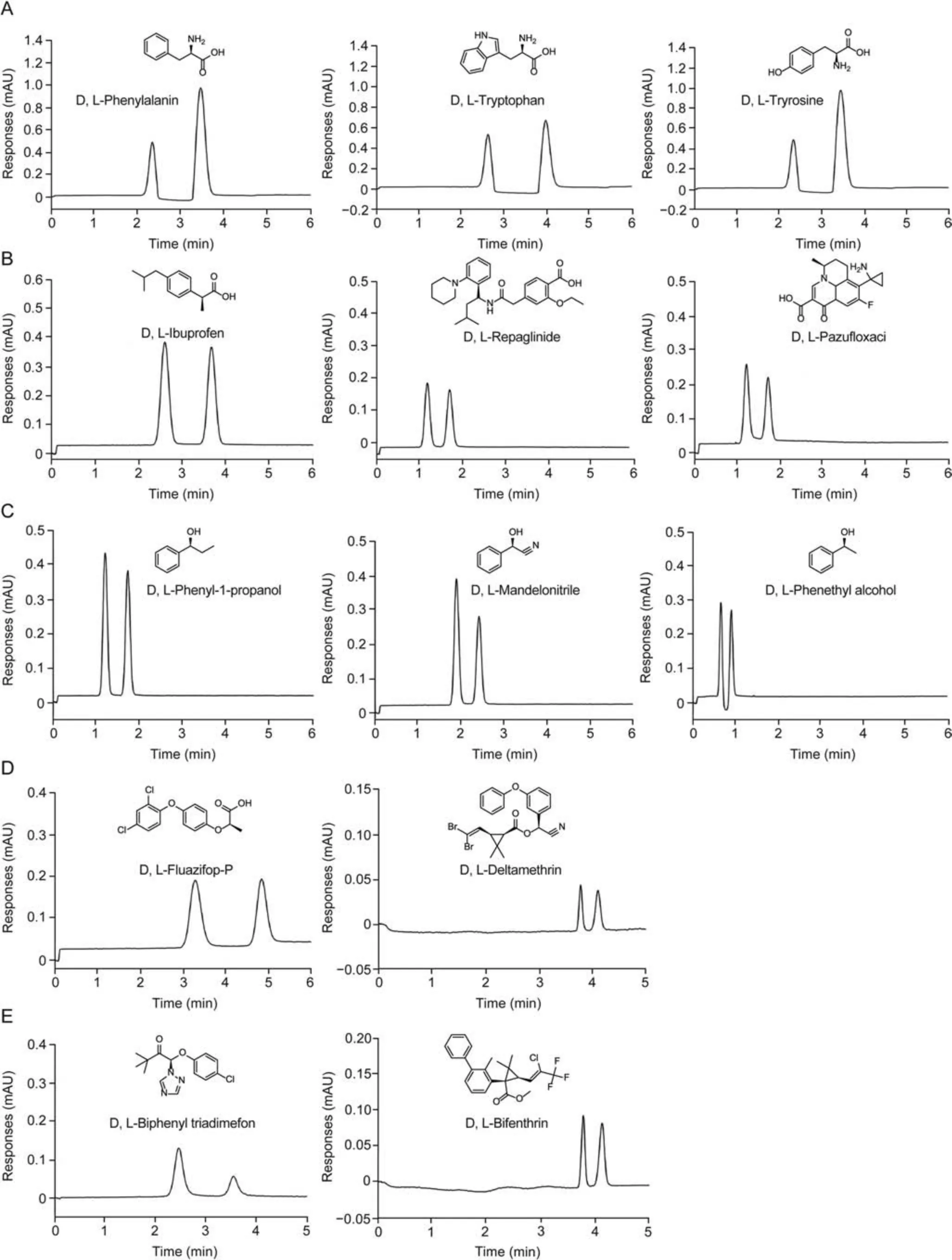
Fig.11 .The optimum conditions of nanocellulose derivatives and SiO2 hybridization open tubular capillary electrochromatography column for determining the analytes.(A)Amino acids, (B) chiral drugs, (C) chiral phenylethanol compounds, and (D) pesticide residues.Reprinted from Ref.[103] with permission.
3.4.3.Others
Vancomycin is an amphoteric glycopeptide antibiotic with chiral active sites.Last year, Xing et al.[41] used vancomycin and diazo resin coupled coating as an SP to separate four isomers of chlorpheniramine, benzoin, promethazine, and D/L-mandelic acid,and to isolate four mixed proteins.Interestingly, the following substances also played a role in chiral separation.The selfassembled supramolecular membrane coating method developed by Li et al.[42] was used to help coat phase-transitioned BSA(PTB) films onto OT columns.It can be used to separate eight chiral drugs and neurotransmitters.Because bacteria have intrinsic chirality,adhering non-pathogenic Escherichia coli(E.coli)DH5α to the inner wall of the OT column prepared by adhering to positively charged polyethyleneimine can baseline separate enantiolate fluoroquinolone isomers and ofloxacin, as well as partially separate lomefloxacin enantiomers [104].It is even possible to use the E.coli expression system to produce recombinant chicken α1-acid glycoprotein(α1-AGP)and modify it in the column after pretreatment [105].This column has chiral recognition ability and can separate three basic drugs.1,1′-bi-2-naphthol (BINOL), the guest molecule for assessing the separation ability, was used as the SP of the OT column [43], being able to separate chiral alcohols,amines,ketones,etc.This suggests that some analytes with chiral recognition properties, such as some drugs, antibiotics, proteins, and non-pathogenic bacteria, can be used as SPs for enantiomeric separation.
3.5.Non-nanopolymer-based SP in OT-CEC
It should be noted that MIPs can specifically separate target analytes(Fig.12)[106].MIPs as SPs are jointly prepared using crosslinking agents, porogens, and functional monomers.Template molecules in the cross-linked MIPs are eluted with a suitable eluent,and the appearing pores have the specific selection ability to recognize template molecules from mixtures.The separation performance of some MIPs is equivalent to that of non-MIP separation technologies, or even better.Dispersive MIP is similar to the micellar electrokinetic chromatography (MEKC) principle, which not only improves the particle size of MIP in the buffer but also reduces the intra-column turbidity and Joule heating during detection [107].Zhao et al.[108] successfully developed a polyhedral oligomeric silsesquioxane (POSS)-based MIP-coated capillary with a coating thickness of approximately 0.1-0.2 μm.The column successfully separated naproxen and zopicillin enantiomers.The Rs of the column prepared using PSS-(1-propyl methacrylate)-heptaisobutyl substitution (MA 0702) was up to 22.3, which is two times higher than that when POSS was not prepared.Furthermore, MIP has been used to isolate common parabens in personal care and cosmetics for assessments of human exposure to them [109].

Fig.12 .Scanning electron microscopy (SEM) depicts the cross-sectional views of various open tubular molecularly imprinted polymer columns with different templates.(A) R-atenolol, (B) S-sulpiride, (C) S-(1-naphthyl)-ethylamine, (D) S-methyl benzylamine,(E)S-ketoprofen,and(F)S-methylsuccinic acid.Reprinted from Ref.[106]with permission.
Polymer materials can be used to separate carbohydrate isomers and chiral drugs.The N-phenylacrylamide styrene-copolymercoated column was developed for the separation of para-aminobenzoic acid ethyl ester (ABEE)-labeled sugar isomers (maltose structural isomers) with an outstanding separation efficiency(N >1 million) [110].Zhao et al.[44] constructed a novel block copolymer capillary column using the reversible additionfragmentation chain transfer (RAFT) radical polymerization method.The SP was poly (maleic anhydride-styrene-Nisopropylpropene) amide), which achieves baseline separation of three chiral drugs and three β-lactam antibiotics (cefradine, cephalexin,and amoxicillin)in human serum samples.The bilayer thinfilm copolymer coating [45] prepared by an in-column successive reaction also shows excellent performance in the separation of peptides and trypsin digests.
4.Applications
4.1.Application of OT-CEC in medicine
4.1.1.Metabolomics
Metabolomics has developed from the foundations of proteomics and genomics.It is used to study small molecule metabolites of substrates and products of various metabolic pathways to diagnose malignancies, perform drug screening, or evaluate drug toxicity.The important utilization of OT-CEC in biomolecule separation and analysis can be seen from the above discussion.OT-CEC columns are widely used for protein isomers, mixed proteins, sugar isomers, sugar isoforms [111], separation of peptides [112], nucleobases, and nucleosides [84].The OT column, which is modified with a 32-membered ring, the macrocyclic polyamine ligand 1, 5, 9, 13, 17, 21, 25, 29-octaazacyclotricarbane, was used to separate p-aminobenzoic acid-derived monosaccharides and disaccharides [113].Surprisingly, the thrombin-catalyzed in situ polymerization method using fibrin as the OT column coating also separates monoclonal antibodies [114].With pH = 5.7 as the boundary, the EOF direction changes when the pH is changed.It can separate variants of the three mAbs (cetuximab, trastuzumab, and rituximab).In modifying rabbit platelets in an affinity capillary OT column(Fig.13), electrochromatography combined with turbidimetry can be used to evaluate affinity interactions between small molecules and platelets, as well as antiplatelet aggregation activity induced by small molecules [115].In the sol-gel solutioncoated OT column, after alliin or capsaicin (in two forms:extracted from plants or just pure synthetic chemical additives)was modified on the capillary inner wall, it could separate two neurotransmitters, oligopeptides, and nucleotides [116].
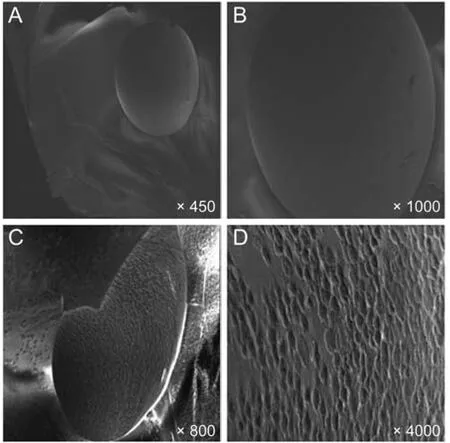
Fig.13 .Scanning electron microscopy (SEM) depicts the bare column and the rabbit platelets affinity open tubular (OT) column at different magnifications.(A) The bare column at 450×, (B) the bare column at 1000×, (C) the rabbit platelets affinity OT column at 800×, and (D) the rabbit platelets affinity OT column at 4000×.Reprinted from Ref.[115] with permission.
4.1.2.Drug separation
OT-CEC also works well in achiral drug separation.Octadecylamine (ODA)-coated columns show good separation performance,and permanent OT columns [46] can separate acidic, neutral, and basic drugs.Further combinations with PDA have expanded the range of applications for drug separation [47].Besides separating drugs,OT columns have been used for quantitative analysis of drugs in clinical samples[48].Analytes without chirality can be separated by hydrazine-linked COF (Tf-DHzOH) [49], MNP-β-CD-IL [7], and the mixture of GOs and MoS2[50].It is worth noting that using β2-adrenergic receptor (β2-AR) as the coating [51] can determine the Kb value of four Paeonia lactiflora peony extracts with respect to affinity, which indicates that OT-CEC may be an effective method for predicting drug activity and searching for lead compounds from traditional Chinese medicine (TCM).
4.1.3.Clinical and others
Clinically combined metabolomics is used to judge the correlation between pathogenic factors and disease progression by metabolites detected in biological samples (plasma, serum, urine,saliva,and hair).The former part mentions the OT columns used in the clinical analysis of biological samples.Another example is the research reported by Fukushima et al.[117] on the relationship between plasma branched-chain amino acid levels and dyslipidemia in non-diabetic individuals.Metabolomics is based on proteomics and genomics.Neutral fluorocarbons (FC), neutral polyvinyl alcohol (PVA), and cationic polybrene-dextran sulfate-polybrene(PB-DS-PB) [118] also frequently exist as coating materials for separating proteins.They help maintain chromatographic peaks in good shape and avoid tailing caused by excessive adsorption to the SP.CE/MS quantifies blood metabolites and fatty acids and is not inferior to reverse phase liquid chromatography with mass spectrometry (RPLC/MS) and GC/MS [119].Nano-capillary electrophoresis electrospray ionization with mass spectrometry (Nano-CESIMS) often combines two detection methods: one is online preconcentration/stacking to minimize the final sample volume and the other is a large-volume dual preconcentration method using isotachophoresis and stacking (LDIS).Surface sampling capillary electrophoresis mass spectrometry (SS-CEMS), published in 2019,provides a concise and direct method to analyze the chemical signatures of defined regions of complex tissues.It enables nontargeted and simultaneous screening of endogenous molecular species, ranging from small metabolites to region-specific polypeptides without any sample preparation or tissue dissection(Fig.14).It is the first non-targeted metabolite analysis technique applied to the kidney and brain tissue by online CE/MS [120].

Fig.14 .The schematic diagram of the surface sampling capillary electrophoresis mass spectrometry.OD: outside diameter;ID: inner diameter; and ESI: electron spray ionization.Reprinted from Ref.[120] with permission.
4.2.Application of OT-CEC in food and cosmetics
Additives in food and certain harmful ingredients in cosmetics in excess can also be detected using OT-CEC.The capillary column prepared by introducing soluble zinc-derived MOC [Zn2L] into the pretreated PDA inner wall can separate and detect food additives(such as parabens, vanillin, and related phenolic compounds) by forming π-interaction and hydrophobic interaction with analytes.It is also applied to neutral compounds, acidic drugs, and even nucleosides and nucleotide bases[52].EEDs are widely distributed in the air, water, and soil and can destroy the stability of the human endocrine system and cause harm to fertility.BPA and its analogs have been linked to cardiovascular diseases, breast cancer, and prostate cancer.They can be transferred from plastic packages to food during transportation and storage.The N0-COF column can accurately separate and detect BPA and its analogs in beverages with a recovery rate of 91.0%-112.0% [3], and other substances in the beverage do not affect the result.In other EEDs,porous coatings of borate-grafted polyethyleneimine [121] can enrich cis-diol polyphenols in fruit juices.Nucleotides in chicken seasoning can be determined using the Schiff base framework (SNW) [53].An OT column coated with PEG-MoS2as the SP [54] was able to stably measure nine sulfonamides.It has been used in aquatic environments and for milk determination.The carcinogenic N-nitrosodiethanolamine content in cosmetics [122] can also be determined using CEC.
4.3.Application of OT-CEC in environment and biology
CEC plays an important role in environmental monitoring and biocomponent analyses.Exhaust gas and wastewater from heavy industry and agricultural fertilizer applications are increasingly introducing heavy metals and other harmful substances into the environment, which leads to a genetic “three-way” effect if they interact with DNA.Using DNA probes as SP can screen target contaminants by comparing the affinity between contaminant samples and single/double-stranded DNA (s/dsDNA) [123] for more information on the pollutants.The styrene (St) and itaconic acid copolymer PLOTcolumn[55]and the spherical vinyl-functionalized COF (COF-V) OT column [56] can detect pyridine and triazine herbicides, respectively.The nano-sized MIL-101 can detect pesticides and anthraquinone dye components [124] in water.Nitrophenol, an EED, can be separated using a 2D azide-bonded COF(ACOF-1) SP [57].Biologically, PDA-modified poly(ether ether ketone) capillaries exhibit good separation of plant hormones [125].Certain parts of plants are enriched in copper and cadmium.Heavy metals can be detected at the μg/kg level by the c-MWCNT OT column, with recoveries ranging from 98.2% to 101.5% and good repeatability [58].
5.Application of CE combined with other determination equipments
CE is frequently used in biological sample analysis.CE has a higher selectivity and separation efficiency and requires fewer reagents.CE/MS has the advantages of rapid and high-Rs separation, sensitive and selective detection, small sample size, and suitability for cell analysis [126] and metabolite analysis in biological samples [127].Particularly, when testing highly polar and charged metabolites (such as sugar phosphates, nucleotides, and AAs) [128], it has unique strengths.It promotes the use of biomarkers and their variants [129] for disease diagnosis [130,131]and clinical applications.CE/MS is an indispensable tool for predicting disease progression, risk stratification, and personalized treatment [132].However, uncoated fused SiO2capillaries[133,134]and sheath fluid flow coupling remain the first choice for clinical detection, and the established sheathless CE/MS system performs label-free ultrasensitive assays [135].Monolithic column capillaries[136-138]are superior to OT columns in practical applications.
In theory, the highest sensitivity and Rs can be obtained by combining coated capillaries with sheathless interfaces [139].For example,bispecific antibodies(BsAbs)represent the next generation of antibody-based drugs with enormous structural heterogeneity.Gst¨ottner et al.[140]used positive-coated capillaries and background electrolyte composed of 3% acetic acid for complete detection to obtain assessment data of macroscopic and microscopic heterogeneity of BsAbs by using sheathless CE/MS(Fig.15).Surprisingly,Wang et al.[59]integrated OT-CEC into sheathless MS for underivatized AA enantiomers separation using a PLOT@Au@CD column in 2022(Fig.16).It can baseline separate 15 pairs of chiral AAs within 17 min with high column efficiencies, which may realize a quicker, easier,and higher flux separation method for metabolomics and other fields.
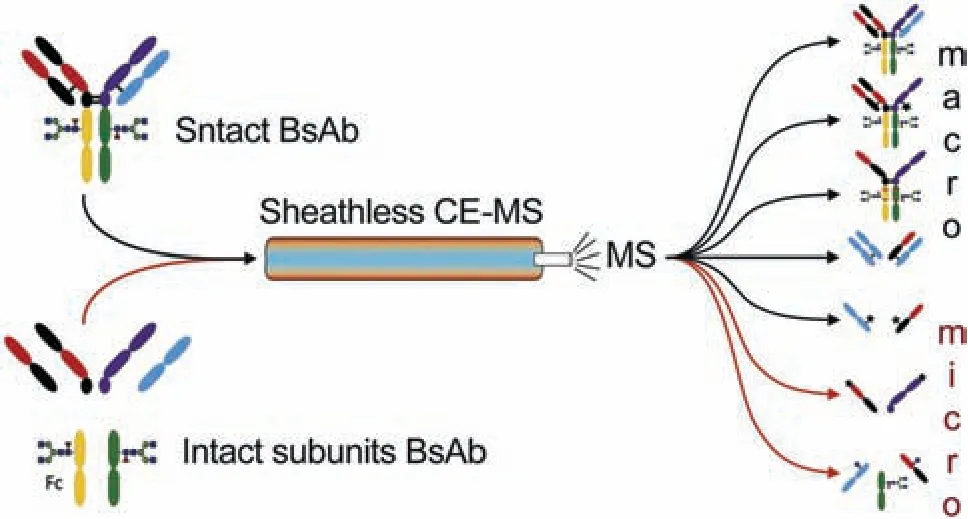
Fig.15 .The schematic diagram of assessing macro/micro heterogeneity BsAbs by sheathless capillary electrophoresis with mass spectrometry.BsAbs: bispecific antibodies; CE: capillary electrophoresis; MS: mass spectrometry; and Fc: one subunit of the BsAbs.Reprinted from Ref.[140] with permission.

Fig.16 .The schematic diagram of open tubular capillary electrochromatography with mass spectrometry.PLOT: porous layer open tubular; Au: aurum; CD: cyclodextrin;AAs: amino acids; and ESI-MS: electron spray ionization with mass spectrometry.Reprinted from Ref.[59] with permission.
To effectively overcome these problems, improving the preparation or connection method and cooperating with other technologies may increase the possibility of using OT columns with other detections.For one thing, chemical etching increases the inner surface area of capillary columns by over 1000 times [141].For another,using polyetheretherketone[125]instead of SiO2can solve coating easy swelling and aminolysis problems at the end interface of the CE/MS connection when it is exposed to solutions and overcome the EOF instability.In other words,they can also achieve significant improvements.For example, explorations of new coating materials extend the detection range [56], PLOT columns[55] help facilitate the CE/MS connection, and optimizations of synthetic strategies and coating methods enhance column stability[142].With effective enrichment methods,sample stacking,such as on-site amplification,can expand the detection range of CE-MS/MS to 3579 peptides and 1141 proteins (FDR = 1%) [143], even exceeding the nano-LC/MS performance.
Capillary electrophoresis with an ultraviolet light detector (CE/UV)can also detect biological samples.The limitation of CE/UV is its low sensitivity, which is related to the short optical path length of the capillary in the detection cell and the small amount of the injected sample.This can be improved by sample preconcentration[71].Wang et al.[60]used a combination of miniaturized CEC and the electrochemical detection system (mini-CEC-AD) with the LHis-ZIF-8@OT column to separate AAs, chiral drugs, and neurotransmitters with good sensitivity and low cost.Other methods[144] include coupling GC-CE and LC-CE, which improves their selectivity.2D CEs (e.g.capillary zone electrophoresis-capillary zone electrophoresis (CZE-CZE) [145] and CZE-micellar electrokinetic chromatography (CZE-MEKC) [146]) also have the potential for separation.
6.Conclusion and perspectives
In the past three years,advanced functional materials used as SP in OT-CEC have attracted the attention of scientists worldwide.Among them,the application of microporous materials and NPs has gradually increased, accounting for approximately 62%.Although extensive studies are being conducted,the application of functional materials in OT-CEC is still in the preliminary stage.For classical SPs,CD remains modified and improved in several OT columns within 10 years.Besides chiral drugs, OT columns can also separate carbohydrate isomers,biological samples,and other analytes.The adjustable pore size of porous materials is a significant way to expand the column application range,which is worth investigating.Classifications of non-nanopolymeric coatings include knitted aromatic polymers[147],tentacle-type zwitterionic polymers[148],and liquid crystalbased low-crosslinking MIP coatings [149].A few interesting chiral separating SPs developed in recent years have been shown in Section 1.4.3.And it deserves notice that stimuli-responsive polymers[150]are a kind of potential material for protein isomerism and glycoisoform separation.Non-traditional materials[151,152]have also been used in OT column coatings for achiral separation.Some of these coatings partially solve the previous limitations of OT columns.
However, there is considerable room for expansion in the discovery and application of new advanced functional materials as SPs because only a handful of them have been applied to practical applications such as CE/MS.NPs play an irreplaceable role in the separation of small biological molecules.The results of the protein coronacapillaryelectrophoresiswithelectrospray ionization mass spectrometry (CE-ESI-MS) analysis of NPs were significantly better than the protein corona detection gold standard nano-LC/MS [153].Metal NPs with different physicochemical properties in OT capillary coatings can be used to discover new SPs.This may bring a new idea to OT columns applied for CE/MS.The main barriers to introducing CEC/MS into the analysis market still focus on the OT column interface, and the impact of low sample loading.Other limitations include inner coatings, which are easily affected by buffers,limited stability,and robustness[154].In 2022,the PLOT@Au@CD OT column[59]with the interface of the porous tip coupled with MS successfully separated 15 pairs of chiral underivatized AAs in vinegar samples within 17 min in a sheathless CE-ESI-MS system.OT-CEC is mature in chiral and isomer components separation nowadays, and also has a certain foundation in terms of molecules in different sizes.It will better display its trace and sensitive advantages with other instruments for more discoveries through easy preparation and detection conditions.We should continue to find new solutions to prepare new OT columns and their combinations with other technologies and equipment.
In summary, we have discussed the applications of OT-CEC in chiral separation over the past four years based on coating materials and replenishing classic OT column coatings.A summary of OT-CEC,CE/MS,and other technological applications in some fields is provided in this review as well.
CRediT author statement
Xinyu Li:Investigation, Formal analysis, Writing - Original draft preparation;Qianjie Ma:Investigation, Resources, Writing -Reviewing and Editing;Xiangtai Zheng:Resources, Writing -Reviewing and Editing;Qin Chen:Conceptualization, Supervision;Xiaodong Sun:Conceptualization,Supervision,Writing-Reviewing and Editing,Funding acquisition.
Declaration of competing interest
The authors declare that there are no conflicts of interest.
Acknowledgments
This study was funded by the Project of National Natural Science Foundation of China (Grant No.: 82003705), and the Shanghai Science and Technology Innovation Foundation (Grant Nos.:23010500200 and 23ZR1422700).
 Journal of Pharmaceutical Analysis2023年4期
Journal of Pharmaceutical Analysis2023年4期
- Journal of Pharmaceutical Analysis的其它文章
- Neutrophil elastase: From mechanisms to therapeutic potential
- Development of a CLDN18.2-targeting immuno-PET probe for non-invasive imaging in gastrointestinal tumors
- High-throughput transcriptional profiling of perturbations by Panax ginseng saponins and Panax notoginseng saponins using TCM-seq
- A chiral metal-organic framework {(HQA)(ZnCl2)(2.5H2O)}n for the enantioseparation of chiral amino acids and drugs
- Quantitative characterization of cell physiological state based on dynamical cell mechanics for drug efficacy indication
- Solriamfetol impurities: Synthesis, characterization, and analytical method (UPLC-UV) validation
